The world after COP26 – is there still hope?
As the dust settles on Glasgow, how do we keep the COP26 momentum alive and provide hope for our future?
In the weeks running up to and during the event, our phones were endlessly buzzing with COP26 news. Day after day – a flood of headlines, newsletters, social media posts, stories in our notifications… It was overwhelming to say the least!
Now, a week after negotiations came to a close and the final Glasgow Climate Pact was drafted, the public eye is turning its gaze to new matters.
But as the dust settles on COP26, and the media buzz quietens, we wonder: is that it? Is the world saved from climate catastrophe? The answer is no, and far from it.
I was in Glasgow volunteering for the COP26 Coalition during the climate conference. Read on as I share my take on the event, on the world after COP26, as well as some stories of the people who are keeping the COP momentum alive and giving us hope for a future where people and nature can thrive.
The expectations we had for COP26 and the disappointment we are left with
If you have seen or heard any of the climate chatter, you will likely have heard reference more than once to the elusive “1.5°C”. This was part of the key targets for the United Nations Climate Change Conference, aka COP26.
When world leaders met in 2015 in Paris, for COP21, 196 countries signed a binding international treaty on climate change. One of its main focuses was to limit the threat of climate change by ramping up efforts to keep global warming well below 2°C, and preferably below 1.5°C, compared to pre-industrial levels. Scientists have predicted that 1.5°C warming is the limit beyond which some of the damage to the Earth’s climate will become irreversible.
Six years after Paris, COP26 Parties were expected to officially commit to the much safer limit of 1.5°C. Sadly, after two weeks of intense negotiations within the walls of the conference venue in Glasgow, experts estimate that we are only now on a path to between 1.8°C and 2.4°C of warming, based on government commitments made at COP26. Talk about “code red for humanity” – Code scarlet more like!
World leaders have however now agreed to revisit their pledges by the end of 2022 to put us on track for 1.5°C of warming. But immediate ACTION must be taken. NOW!
The failure to commit to a safe cap on global warming is not the only commitment that COP26 fell short of.
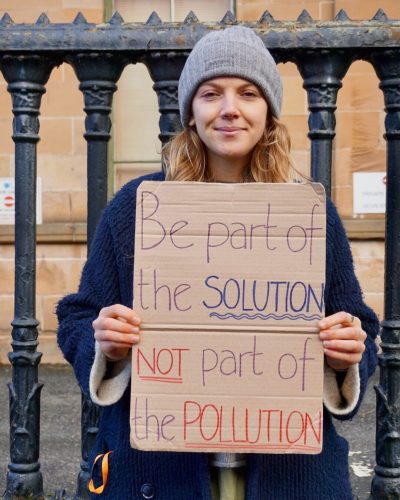
Where are the plastics pledges?
Since Mooncup began back in 2002, we have been fighting for a world with no period plastic waste on our beaches.
Virtually all plastic is made from chemicals sourced from fossil fuels, and the fossil fuel and plastic industries are deeply connected. Understanding these links is key to tackling the global crisis of plastic pollution.
Plastics account for extortionate levels of greenhouse gas emissions, and form one of the fastest growing industries. By 2050, the carbon emissions generated by the plastics industry will represent an astounding 13% of the world’s remaining carbon budget (the maximum amount of carbon our world can take before tipping over the 1.5°C “danger line”).
The production of plastic is accelerating the climate crisis, and there is no denying it.
And then there’s plastic pollution, of course. Every single item of plastic ever produced is still present on our planet, in some form. When plastic enters the waste stream, it stays there, in landfill, our oceans or on our beaches, damaging our ecosystems, for hundreds of years before it decomposes.
Period plastics are no exception! Conventional tampons or pads can contain up to 90% plastic (that’s not counting the applicators, wrappers etc.). It is estimated that one disposable pad will take up to 500 years to decompose. When you consider that one of us alone will use around 11,000 single-use period products in a lifetime… that’s a LOT of plastic littering our world.
You’ll likely have guessed that plastic production and pollution are challenges that are part of our everyday conversations here at Mooncup Ltd. So, we were hopeful for some real plastic-busting commitments at COP. Needless to say, we were far from satisfied…
As Sian Sutherland, Co-Founder of A Plastic Planet highlighted in a BBC interview, plastic production and pollution were simply not on the agenda at COP. And it’s hardly surprising when the biggest delegation at COP26 was held by the fossil fuel industry lobby!
The most exclusive, not INclusive COP, yet
To quote the official COP26 website, “a priority for the COP Presidency [was] ensuring an in-person and inclusive summit, because we believe that is essential to success at COP26 and delivering for our planet.”
However, and you have guessed it, there is a “BUT”… Even before the conference kicked off, it became clear that this COP was to be more exclusive than ever before.
The Cop26 Coalition – an organisation representing vulnerable communities, indigenous movements, trade unionists and youth strikers the world over – confirmed that COP26 “was the most elite and exclusionary COP ever held.” Lack of access to Covid_19 vaccines, shifting travel rules, visa issues, and scarce (not to mention expensive) accommodation all played their part.
No climate justice without social justice. No social justice without gender equality
At Mooncup Ltd, a company run by women, we have been transforming the conversation and smashing the period taboo for almost two decades. We are particularly aware of the importance of women in the climate conversation.
The empowerment and education of women and girls are some of the most impactful tools available for avoiding emissions. Research found that for every additional year of schooling a girl receives on average, her country’s resilience to climate disasters is improved significantly.
Improved access to education and family planning reduces unplanned pregnancies, resulting in better health prospects for both parents and children, and less pressure on resources. Menstrual health is a key part of reproductive education and is intrinsically linked to four of the UN’s Sustainable Development Goals.
By staying in education longer, girls also have improved access to gaining the skills and knowledge that will stand them in better stead for becoming community leaders.
When it come to the effects of climate change, inequalities mean women around the world are disproportionately impacted. According to the UN, about 80% of people displaced by climate change are women, due to flooding and drought. Not to mention the fact that, globally, they’re more likely to experience poverty.
Women need to be given a greater seat at the table
Research shows that female representation in national parliaments leads to more rigorous climate policies and a reduction in greenhouse gas emissions.
So, if we are to address climate justice in the most inclusive and representative way, and offer comprehensive and durable solutions, women need to be given a greater seat at the table.
Mary Robinson, ex UN high commissioner for human rights, has often criticised the lack of women representation at COPs. This has been confirmed by data from in a UNFCCC secretariat report: “We need to centre women and girls in the climate context – women need to be included at the table. The UK promised the most inclusive Cop, but it is not.”
Progress has been made, but it is estimated that gender parity in climate leadership will only be achieved in 2068.
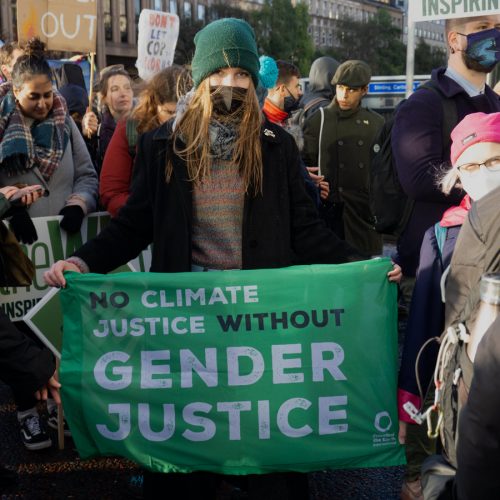
Female representation and participation are, on the other hand, much more positive in the civil society sector, and they occupy a larger share of Non-Governmental Organisations positions.
So, in this world after COP26, as the buzz of it all dies down, the challenge of climate justice lives on, and the battle is far from won. But there are inspiring people keeping the momentum going!
Tales of true climate activists giving us hope
Other than the well-known climate legends such as Greta Thunberg, one positive trend I have witnessed is the rise of emerging figures leading us forward in this fight for true climate justice.
While in Glasgow, I spent several days volunteering at the COP26 Coalition civil society events. In stark contrast to the somewhat half-hearted commitments that were being made each day within the official COP26 venue, I experienced first-hand the energy, passion and sincere commitment that real climate activists from all four corners of the globe brought to the table.
I felt this energy particularly strongly on Saturday 6th November, on the Global Day of Action. Thousands, if not tens of thousands, of us marched the streets of Glasgow for climate justice. All united by one, common cause: to cut through the “blah, blah, blah” of world leaders and to foster real, positive change for people and planet.
Meet the #RealClimateActivists
I had the opportunity to interview a few members of the global community of activists – real-life people that are driving this movement of climate justice on.
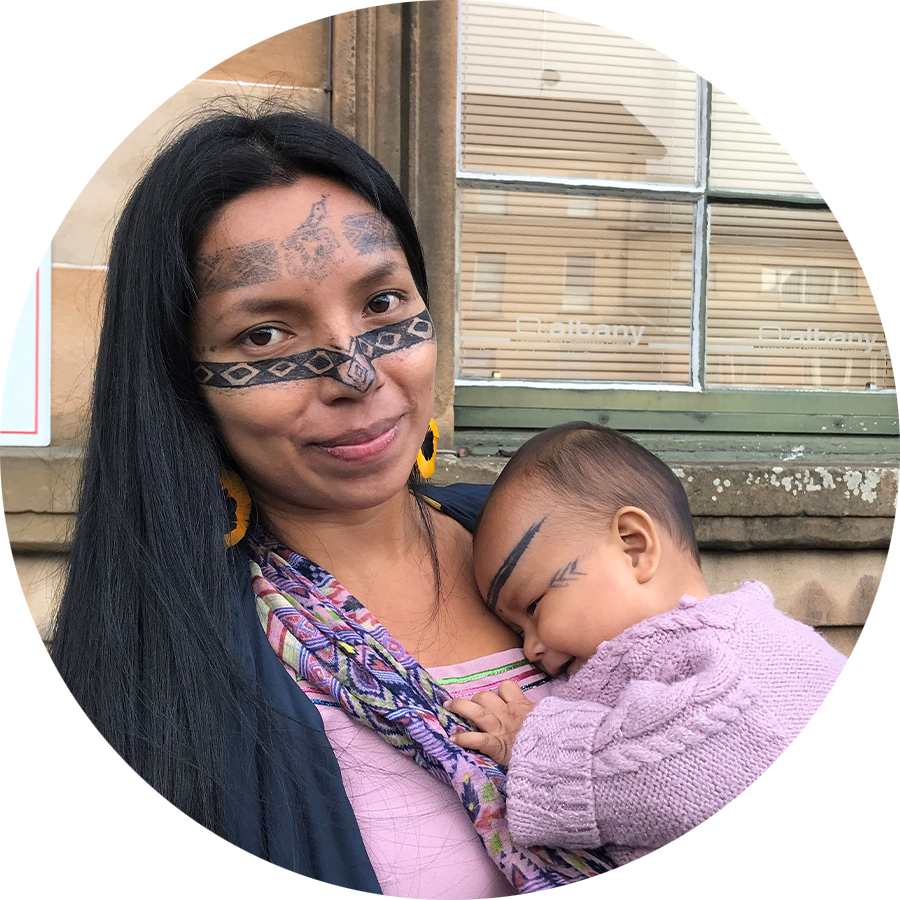
Abigail Gualinga
Abigail Gualinga is a youth leader from the Kichwa village of Sarayaku, in the Ecuadorian Amazon. Abigail has participated in events around the world, sharing her community’s vision of protection and care of nature. On behalf of her community, Abigail works to ensure that her living territory remains free of any type of extractive activities (such as coal, gas, etc.).
I met this inspiring young mother outside a COP26 Coalition event about fossil-free zones.
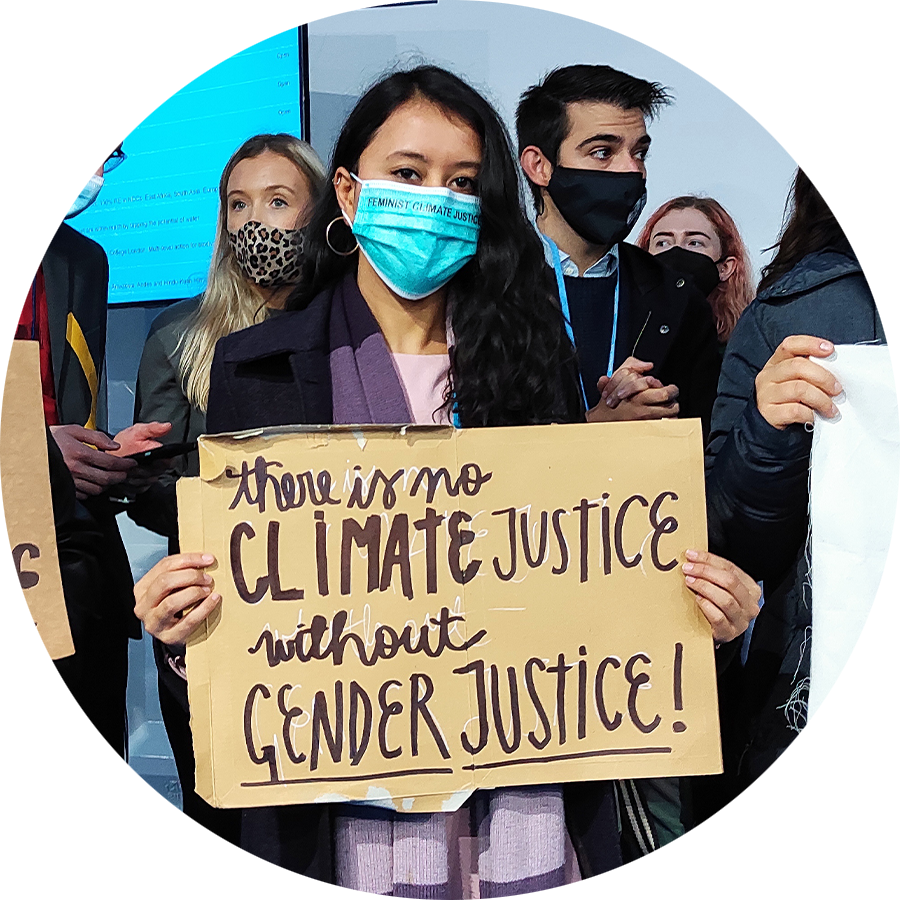
Arati Poudel
Arati Poudel is a research officer on the Climate Justice Programme at Digo Bikas Institute, in Nepal. Arati has approached climate activism through policy intervention, capacity building and environmental programmes and campaigns.
Needless to say that Arati’s ‘feminist climate justice’ face mask drew my attention. And after our interview we had the opportunity to discuss the complex topic of menstrual health and period products in Nepal. Arati is a true inspiration.
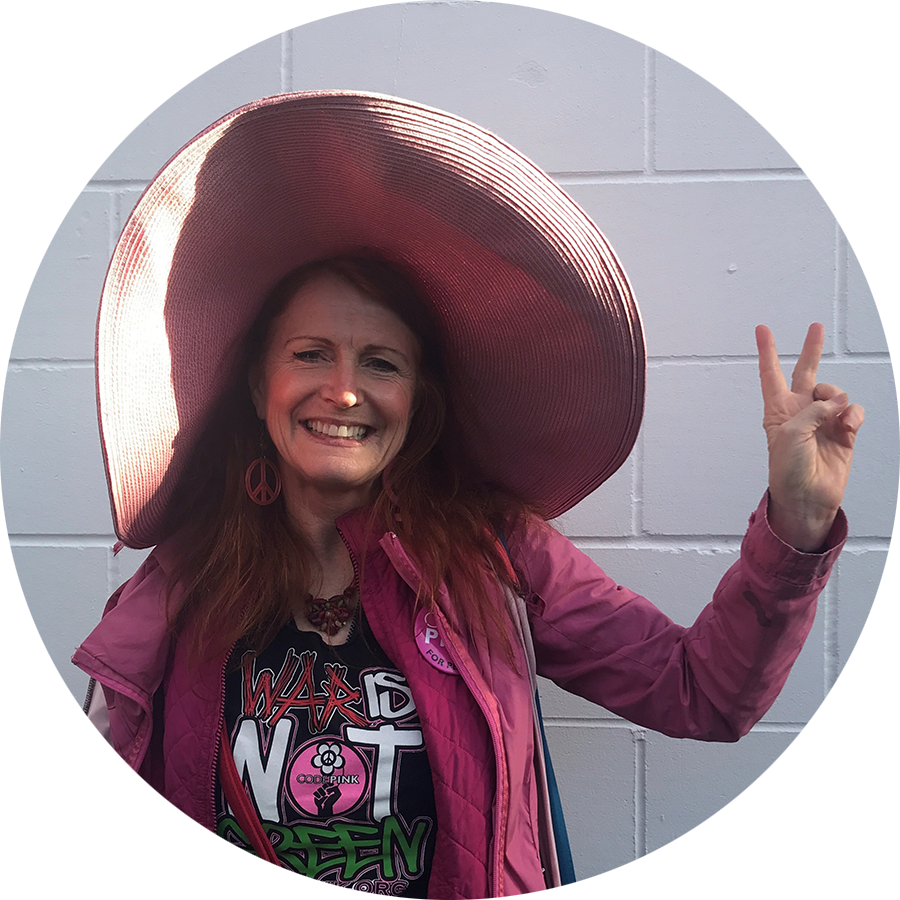
Jodie Evans
Jodie Evans is a political activist, author, and documentary film producer from the U.S.A. Jodie is also the co-founder of non-profit organisation Code Pink. Her matching outfit and glowing demeanour drew me to snatch an interview with her on my way to catch the train home from Glasgow.
Jodie’s activism is centred around peace and justice, environmental causes and women’s rights.
Head to our Instagram story highlight (‘Activists’) to hear their full interviews.
“People got the power” – together, we can make a difference
The ultimate dream is for system change – real intersectional change that permeates through every sector of society and its structure. A just transition which benefits all. We need governments to not only commit to change, but to instigate immediate action, for the sake of our planet and its people.
But in the meantime, we can use our people power.
One of the workshops I attended as part of the COP26 Coalition People’s Summit addressed the issue of staying hopeful in times of climate crisis. One of the speakers reminded attendees that each one of the 50 people present in the room probably all knew another 50 people who are taking climate action.
When I returned home, a 7-hour train journey away from the buzzing streets of Glasgow, it dawned on me that I don’t know 50 people taking climate action. Certainly not in my personal life. I barely know 10. So, if there is one thing I learnt, it’s that we can only keep spreading the word.
Clean up that bit of litter. Sign that petition. Make that sustainable swap. Cycle that commute. Kickstart that campaign you have always dreamt of running. Do. Your. Bit. And, most importantly, grow the movement. Because, in the words of Greta, together “we are united and unstoppable”.
Hope is in the people, cause the “people got the power!” ?
Switching to the Mooncup®️ is a sustainable swap
Switching to the Mooncup menstrual cup is a simple way to reduce your environmental footprint.
With the Mooncup you can have plastic-free, zero waste periods – you only need the one, and it lasts for years and years. Thanks to Mooncup users around the world, we have saved over 2.9 billion tampons and pads from ending up on our beaches or in landfill, since the product was born back in 2002.
The Mooncup is made right here in the UK, taking our manufacturing airmiles right down to zero.
Find out more about our impact here.
From every Mooncup®️ bought, we give £1 to eco non-profit City to Sea
We are proud to have joined forces with City to Sea and to support their campaign fighting period plastic pollution. Each Mooncup bought on our UK site will help City to Sea to reach more people than ever – including those who have been historically excluded from the conversation.
Find out more about the Mooncup menstrual cup and buy yours here.
Did you enjoy this article? Head to this page’s footer to sign up to our mailing list to be the first to hear about our blogs!
You might also be interested in:
What young climate activists expect from COP26
Cal Major, Paddleboarder & #RealMooncupUser, shares one way to help tackle ocean plastic pollution
How is the Mooncup environmentally-friendly?
Meet the teens activists fighting the war against plastic pollution
The pandemic is no excuse to give up our fight against plastic pollution
How to choose the best menstrual cup for you
What kind of person uses the Mooncup?
Woman on a mission to make period products free in Scotland







